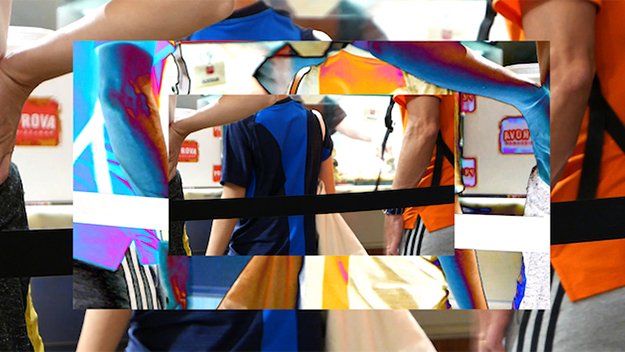Street Magicians
This article appeared in the February 23, 2024 edition of The Film Comment Letter, our free weekly newsletter featuring original film criticism and writing. Sign up for the Letter here.

New York Central (dir. Ernie Gehr, 2020)
Two of the greatest filmmakers to find inspiration on the sidewalks of New York City are featured in back-to-back brain-warping programs at the Museum of Modern Art this month: Fleischer Cartoons: The Art and Inventions of Max Fleischer opened on March 7 and runs through March 14, with 77 anarchic cartoons in 11 programs; and Ernie Gehr: Mechanical Magic screens from March 15 to 24, with 26 varied and adventurous avant-garde films across six programs. Though they worked in different eras and in different modes—Fleischer in animation, and Gehr in avant-garde cinema—their exuberant films share a recognizable New York energy. Both makers were inventors as well as artists, creating new techniques that allowed them to capture the entire scope of urban pandemonium, or what Gehr—a key figure in the New York underground film scene since he made his 1970 short Serene Velocity—described as “the constant barrage of phenomena that comes across.”
With their bustling Manhattan cartoon factory in the heart of Times Square, the Fleischer animators (led by Max and his younger brother Dave) were surrounded by vaudeville and burlesque halls, jazz clubs, dazzling lights, and teeming crowds. This carnivalesque atmosphere pervaded the Fleischer cartoons, embodied in the child-woman Betty Boop, who sang and danced while fending off lecherous pursuers. Cheerfully risqué, especially during their pre-Code heyday, these shorts offered a distinct alternative to Disney’s wholesome fare. While Walt Disney Productions had a story department that carefully crafted plots and developed characters, the Fleischer cartoons feel like they were created on the fly, like jazz improvisations.
The Fleischers’ key technical innovation was rotoscoping. Live-action footage was projected onto the animation stand, so that artists could trace the figures’ movements and morph them into cartoon characters—turning Cab Calloway, for instance, into a dancing walrus in Minnie the Moocher (1932). People and objects constantly transform throughout the films: in the span of a few seconds in Minnie, a flower picks up a spoon to feed Betty, whose angry father’s head has turned into a Victrola, and a naked statuette pulls up a hula skirt to cover herself. Mayhem rules, with everything in the frame undulating and dancing along to a soundtrack of pop songs and hot jazz. Like the city that gave rise to them, their world is one where anything can happen. And the real world enters the frame, too: entries in the “Out of the Inkwell” series from the 1920s open with live-action scenes showing an animator at his drawing board, bringing Koko the Clown to life. In the silent 1924 gem The Cartoon Factory, a rickety vehicle equipped with a fountain pen follows Koko, drawing buildings and objects for him as he speeds through the streets.
Ernie Gehr is now more prolific than ever at 82. An active flaneur armed with a small, lightweight camera, the Brooklyn-based filmmaker says, “I’m a city walker, and a city filmmaker of both interior and exterior phenomena, a chronicler of the invisible daily life in the city.” As intuitive as he is rigorous, Gehr always uses new techniques—not to show off, but to allow us to see the world anew each time. In Back in the Park (2019), filmed during an afternoon in Bryant Park, the camera is pointed toward the ground. We see shoes, fallen leaves, asphalt, shadows, and chairs, and catch snatches of conversation. These fragments add up to a vivid scene; the familiar becomes unfamiliar.
Gehr always shoots like a painter, with keen sensitivity to light and color, and to the nuances of architecture, nature, and human gestures. Though these films are rich perceptual experiences, they also have ethnographic value. Along Brighton Beach Avenue (a.k.a. Untitled: Part One 1981) was filmed from a second-floor window overlooking a busy Brooklyn street, focusing on the interactions of elderly Russian immigrants doing their shopping. The film comprises close-ups—a scarf, a shopping bag, the back of a neck—that are choreographed with rapid-fire editing into a lush cinematic dance. A more recent work, with more relaxed pacing, is Approposessexstreetmarket (2018), whose title alludes to Jean Vigo’s 1930 city symphony À propos de Nice. Filmed in the original Essex Street Market just before it was demolished to make way for the new one, the film captures the sights and sounds of a cluttered, diverse, rapidly gentrifying city space.
One of Gehr’s standout films, Carroll Gardens (2023)—a study of his own neighborhood—is an action painting shot with a rapidly shaking camera, and edited so frenetically that it might make Stan Brakhage dizzy. Like so much of Gehr’s work, it is both representational and abstract at the same time. Walking on a busy city street can feel like being inside a cubist painting, confronting a flood of stimuli. Gehr often reflects this feeling by splitting the screen horizontally or vertically, layering and superimposing footage, and using reflections off of glass windows. He disorients us so that we must constantly reorient ourselves, and emerge transformed.
All of Gehr’s work has the sense of freshness and discovery that characterized early cinema, and several productions, made from magic-lantern slides and stereoscopic footage, harken back to the optical experiments of the 19th century. In a fitting nod to a pioneer of early animation, Gehr titled one of his films In Slumberland (Thanks to Winsor McCay) (2015), and his description of his own work can also apply to the Fleischer cartoons: “So life-like, yet so different! So new yet so ancient! Full of mysteries, pleasures and delight! Enjoy!”
David Schwartz is an independent programmer and writer. He is curator-at-large at the Museum of the Moving Image, where he worked for 33 years, earning a New York Film Critics Circle career achievement award for his tenure.







